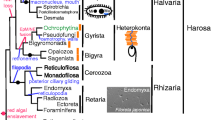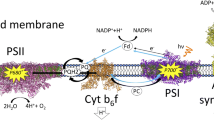Summary
We have determined by protein chemistry methods the amino acid sequence of light chain 2 fromAcanthamoeba castellanii myosin-II (ALC2). This is the first reported sequence for any protozoan myosin light chain. ALC2 consists of 154 amino acid residues, including a single residue of His and two residues each of Pro and Tyr, and lacks Cys and Trp. The N-terminus is blocked, and if an N-terminal acetyl group is assumed, ALC2 has a calculated molecular weight of 17657. ALC2 is an acidic protein, with a calculated net charge of — 7 at pH 7. The sequence of ALC2 is most similar to those of the calmodulins (identity approximately 35%, followed by myosin regulatory light chains. ALC2 appears to lack the potential N-terminal phosphorylation site and single Ca2+-binding site in region I which are characteristic of most myosin regulatory light chains. Instead, ALC2, unlike any other myosin light chain characterized to date, may have a functional Ca2+-binding site only in region II, suggesting a novel role of ALC2 in the Ca2+ regulation of the activity ofAcanthamoeba myosin-II.
Similar content being viewed by others
References
Baba, M. L., Goodman, M., Berger-Cohn, J., Demaille, J. G. &Matsuda, G. (1984) The early adaptive evolution of calmodulin.Molec. Biol. Evol. 1, 442–55.
Babu, Y. S., Sack, J. S., Greenhough, T. J., Bugg, G. E., Means, A. R. &Cook, W. J. (1985) Three-dimensional structure of calmodulin.Nature 315, 37–40.
Babu, Y. S., Bugg, C. E. &Cook, W. J. (1988) Structure of calmodulin refined at 2.2 Å resolution.J. Mol. Biol. 204, 191–204.
Chisolm, R. L., Rushforth, A. M., Pollenz, R. S., Kuczmarski, E. R. &Tafuri, S. R. (1988)Dictiostelium discoideum myosin: isolation and characterization of cDNAs encoding the essential light chain.Mol. Cell. Biol. 8, 794–801.
Collins, J. H. (1974) Homology of myosin light chains, troponin C and parvalbumins deduced from comparison of their amino acid sequences.Biochem. Biophys. Res. Commun. 58, 301–8.
Collins, J. H. (1976) Structure and evolution of troponin C and related proteins.Soc. Exp. Biol. Symp. 30, 303–34.
Collins, J. H. (1991) Myosin light chains and troponin C: structural and evolutionary relationships revealed by amino acid sequence comparisons.J. Muscle Res. Cell Motil. 12, 3–25.
Collins, J. H. &Korn, E. D. (1980) Actin activation of Ca2+- sensitive Mg2+-ATPase activity ofAcanthamoeba myosin II is enhanced by dephosphorylation of its heavy chains.J. Biol. Chem. 255, 8011–14.
Collins, J. H. &Korn, E. D. (1981) Purification and characterization of actin-activateable, Ca-sensitive myosin-II fromAcanthamoeba.J. Biol. Chem. 256, 2586–95.
Collins, J. K., Potter, J. D., Horn, M. J., Wilshire, G. &Jackman, N. (1973) The amino acid sequence of rabbit skeletal muscle troponin C: gene replication and homology with calcium-binding proteins from carp and hake muscle.FEBS Lett. 36, 268–72.
Collins, J. H., Jakes, R., Kendrick-Jones, J., Leszyk, J., Barouch, W., Theibert, J. L., Spiegel, J. &Szent-Gyorgyi, A. G. (1986) Amino acid sequence of myosin essential light chain from the scallopAquipecten irradians.Biochemistry 25, 7651–6.
Coté, G. P., Collins, J. H., &Korn, E. D. (1981) Identification of three phosphorylation sites on each heavy chain ofAcanthamoeba myosin II.J. Biol. Chem. 256, 12811–16.
Goodwin, E. B., Szent-Gyorgyi, A. G., &Leinwand, L. (1987) Cloning and characterization of the scallop essential and regulatory myosin light chain cDNAs.J. Biol. Chem. 262, 11052–6.
Griffith, L. M., Downs, S. M. &Spudich, J. A. (1987) Myosin light chain kinase and myosin light chain phosphatase fromDictyostelium:effects of reversible phosphorylation on myosin structure and function.J. Cell Biol. 104, 1309–23.
Hammer, J. A. III, Bowers, B., Paterson, B. M. &Korn, E. D. (1987) Complete nucleotide sequence and deduced polypeptide sequence of a non-muscle myosin heavy chain gene fromAcanthamoeba: evidence of a hinge in the rodlike tail.J. Cell Biol. 105, 913–25.
Heinrickson, R. L. &Meredith, S. C. (1984) Amino acid analysis by reverse-phase high-performance liquid chromatography: precolumn derivatization with phenylisothiocyanate.Anal. Biochem. 136, 65–74.
Herzberg, O. &James, M. N. G. (1985) Structure of the calcium regulatory muscle protein troponin-C at 2.8 Å resolution.Nature 313, 653–9.
Herzberg, O. &James, M. N. G. (1988) Refined crystal structure of troponin C from turkey skeletal muscle at 2.0 Å resolution.J. Mol. Biol. 203, 761–79.
Kendrick-Jones, J., Lehman, W. &Szent-Gyorgyi, A. G. (1970) Regulation in molluscan muscles.J. Molec. Biol. 54, 313–26.
Klee, C. B. (1977) Conformational transition accompanying the binding of Ca2+ to the protein activator of 3′, 5′-cyclic adenosine monophosphate phosphodiesterase.Biochemistry 16, 1017–24.
Kobayashi, T., Takagi, T., Konishi, K., Hamada, Y., Kawaguchi, M. &Kohama, K. (1988) Amino acid sequence of the calcium-binding light chain of myosin from the lower eukaryotePhysarum polycephalum.J. Biol. Chem. 263, 305–13.
Kohama, K. (1989) Ca-binding light chain of Ca-inhibitory myosin fromPhysarum polycephalum. InCalcium Signal and Cell Response (edited byYagi, K. &Miyazaki, T.) pp. 95–105 Tokyo:Japan Scientific Society Press, and Berlin:Springer.
Korn E. D. &Hammer, J. A. III (1988) Myosins of non-muscle cells.Ann. Rev. Biophys. Biophys. Chem. 17, 23–45.
Korn, E. D., Atkinson, M. A. L., Brzeska, H., Hammer, J. A. III, Jung, G. &Lynch, T. J. (1988) Structure-function studies onAcanthamoeba myosins IA, IB and II.J. Cell. Biochem. 36, 37–50.
Kwon, H., Goodwin, E. B., Nyitray, L., Berliner, E., O'Neall-Hennessey, E., Melandri, F. D. &Szent-Gyorgyi, A. G. (1990) Isolation of the regulatory domain of scallop myosin: role of the essential light chain in calcium binding.Proc. Natl Acad. Sci. (USA) 87, 4771–5.
Leavis, P. C. &Gergely, J. (1984) Thin filament proteins and thin filament-linked regulation of vertebrate muscle contraction.CRC Crit. Rev. Biochem. 16, 235–305.
Malencik, D. A. &Anderson, S. R. (1988) Peptide cross-linking to calmodulin: attachment of [Tyr8] substance P.Biochemistry 27, 1941–9.
Marshak, D. R., Clarke, M., Roberts, D. M. &Watterson, D. M. (1984) Structural and functional properties of calmodulin from the eukaryotic microorganismDictyostelium discoideum.Biochemistry 23, 2891–9.
Maruta, H. &Korn, E. D. (1977)Acanthamoeba myosin II.J. Biol. Chem. 252, 6501–9.
Satyshur, K. A., Rao, S. T., Pyzalska, D., Drendel., W., Greaser, M. &Sundaralingam, M. (1988) Refined structure of chicken skeletal muscle troponin C in the two-calcium state at 2-A resolution.J. Biol. Chem. 263, 1628–47.
Sinard, J. H. &Pollard, T. D. (1989) The effect of heavy chain phosphorylation and solution conditions on the assembly ofAcanthamoeba myosin-II.J. Cell Biol. 109, 1529–35.
Sundaralingam, M., Bergstrom, R., Strasburg, G., Rao, S. T., Roychowdhury, P., Greaser, M. &Wang, B. C. (1985) Molecular structure of troponin C from chicken skeletal muscle at 3-angstrom resolution.Science 227, 945–8.
Tafuri, S. R., Rushforth, A. M., Kuczmarski, E. R. &Chisolm, R. L. (1989)Dictiostelium discoideum myosin: isolation and characterization of cDNAs encoding the regulatory light chain.Mol. Cell. Biol. 9, 3073–80.
Warrick, H. M., Delozanne, A., Leinwand, L. A. &Spudich, J. A. (1986) Conserved protein domains in a myosin heavy chain gene fromDictyostelium discoideum.Proc. Natl Acad. Sci. (USA) 83, 9433–7.
Zot, A. S. &Potter, J. D. (1987) Structural aspects of troponintropomyosin regulation of skeletal muscle contraction.Ann. Rev. Biophys. Biophys. Chem. 16, 535–59.
Author information
Authors and Affiliations
Rights and permissions
About this article
Cite this article
Kobayashi, T., Zot, H.G., Pollard, T.D. et al. Functional implications of the unusual amino acid sequence of the regulatory light chain ofAcanthamoeba castellanii myosin-II. J Muscle Res Cell Motil 12, 553–559 (1991). https://doi.org/10.1007/BF01738443
Received:
Accepted:
Issue Date:
DOI: https://doi.org/10.1007/BF01738443




